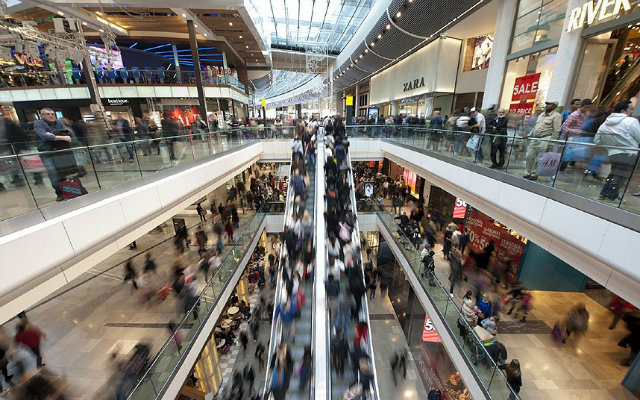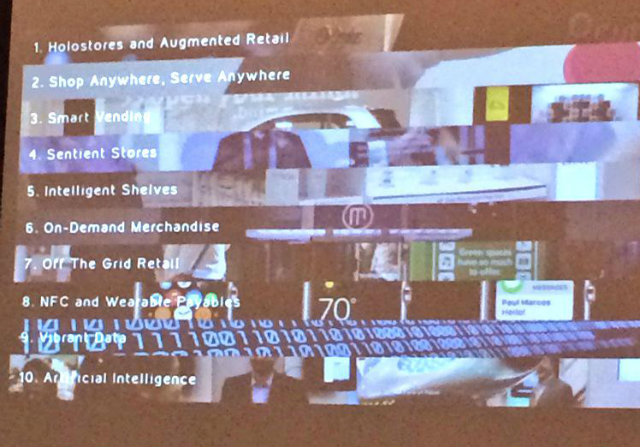
“The future is already here. It is just not evenly distributed.” This quote by the cyberspace guru writer William Gibson introduced one of the most intriguing panels of the 2015 SXSW - South by Southwest - schedule.
‘10 inventions that will revolutionize retail’ - behind this title lies the question so many entrepreneurs are afraid to ask: What does the future of retail hold? Technology disruption changes the rules of production and distribution, and brands need to evolve accordingly, if they want to survive the retail revolution.
The speech by David Roth, CEO of WPP The Store, and Jon Bird, Global Director at Y&R LabStore, is just the starting point for a wider consideration about the evolution of retail customer experience (a crucial topic that we have covered many times). If you look back at the past 50 years, what you see is that brick-and-mortars retail companies have basically followed the same rules over and over, with only slow and gradual changes.
For decades, advertising, product improvement, price and production efficiency have represented the core of all marketing strategies. Push communications and ‘powerless’ consumers were the two sides of the same business coin, and clients were called ‘target’ and clustered into generic and undefined categories. Today, the balance of forces has already changed, putting the customer on center stage and giving birth to the so-called Age of the Customer.
This trend is only destined to accelerate in the current era of rapid technological advancement, where Internet and mobile devices act as catalysts for a massive change in the retail industry. As the SXSW conference made evident, over the next 10 years there is going to be more change than in the last 50 years. Price and products are not enough to differentiate yourself from competitors in the new world that is taking shape, where objects will have the greatest impact on our shopping experience.

Shown below are the 10 tech inventions highlighted by the SXSW panel, and their main consequences on digital customer experience:
VIRTUAL AUGMENTED STORES
The idea of traditional store is meaningless in an world where physical and digital merge into a new level of experience influenced by virtual reality. The enduring success of the Oculus Rift and the launch of Microsoft HoloLens will open new possibilities for retailers: holostores, augmented reality, digital purchases. Neosperience Showroom is the perfect example of how to make your brand and products come alive in immersive 3D reality environments, to deliver powerful experiences.
SHOP & SERVE ANYWHERE
One number says it all: mobile commerce is destined to rise to $62 billion dollars in the next five years. The Internet is already the primary source of information for customers in the decision process. It is also slowly becoming the first reference for purchases. 'Store' doesn't mean just brick-and-mortars anymore. Your online presence is crucial to offer personalized shopping experiences in an omni-channel retail view (mobile first, of course).
DIGITAL SMART STORE
E-Commerce is putting traditional retail on a critical threshold: evolve or die. How can they answer back? Changing the very concept of location and updating the four concrete walls of a shop to the digital needs of empowered customers. The Internet of Things is the final frontier in connecting customers and brands, building engagement through personalization. Here's how to say goodbye to the old layout:
- Smart Vending - connected and built to communicate with customers and other machines. A good case study is the Nespresso boutique in Barcelona, a big vending machine store.
- Sentient Stores - the iBeacon technology is rapidly becoming the standard in traditional stores. Beacons enable you to engage customers with context-aware contents and personalized offers and notifications.
- Intelligent Shelves - shelves won't be just places to display products. They will ultimately recognize the customer, connect and interact with mobile devices to understand his/her needs and wants in that exact moment.
- Artificial Intelligence - the interconnection of objects, made smart by the Internet, brings the concept of 'artificial intelligence' back to attention. Futuristic designers see the advanced store as a sentient entity with a beating heart of chips, wires and bytes.
ON-DEMAND MERCHANDISE
Since the globalization became the major force in Western economies, many insisted that the world has become flat. Actually, the only things going flat are products price and quality. In the Age of the Customer, needs and desires are all but flat: now that they can have whatever they want whenever they want it, customers look for personalized contents and products. Online and offline. That's why we are facing the era of Me-Commerce (even more true when we talk about millennials).
OFF THE GRID RETAIL
If your strategy can't be just centered around the traditional 4 P's of marketing, you need something different to build a distinct brand image and remain the focus of customer's attention. Success will shine out for entrepreneurs that will take a distinctly ‘outside the box’ path to innovation. Again, there is another 'P' you should always include in your strategy: personalization. A tailored shopping experience is the real brand differentiator, when customers demand compelling experience not just useful products.
All analysts agree that the use of Internet and mobile devices will change the way we buy things, and - even more important - the way we pay for products or services. Credit and debit cards will still be the standard in the coming years, but new technologies are at work to offer a more easy, fast and secure access to payments. The last stage of the customer journey is undergoing a fast development thanks to the NFC and the Apple Pay system, that will finally make the wearable revolution the real deal for investors.
VIBRANT DATA
Smart machines can communicate without human intervention. An ecosystem of smartphones, smartwatches, activity trackers, iBeacons, geo-fencing tools, virtual reality headsets (and so on) that creates data, gathered and ready to be used. Big data is the name of this amount of information about customers, production and sales: numbers that you must learn to scan and analyze to make better strategic decisions, improve the customer experience, reduce inefficiency and - ultimately - increase sales.
As a result of all innovation forces, the retail world is increasingly globalized, digitized, polarized and personalized. Too many retailers instinctively react to these challenges using the old easy way out to close under-performing stores, but the resolution is somewhere else: in the reinvention of the physical store and the adoption of those disruptive inventions that drive digital innovation and revolutionize retail as we know it.
YOU MIGHT ALSO LIKE: Retail Marketing Strategy - 5 Steps To Renew Customer Experience
To help you ensure a strategic advantage to your organization, learn about the DCX 7-Steps Checklist crafted by Neosperience, with requirements and insights for a successful digital transformation.



 Your magnifing glass to deeply understand your users and increase the value of each relatonship.
Your magnifing glass to deeply understand your users and increase the value of each relatonship. Listen to the voice of your customers deeply to understand what they truly want.
Listen to the voice of your customers deeply to understand what they truly want. The Lead Generation Platform to get leads from anonymous traffic on your website.
The Lead Generation Platform to get leads from anonymous traffic on your website.  Understand the behavior of people in physical spaces and monitor safety requirements.
Understand the behavior of people in physical spaces and monitor safety requirements. The Digital Commerce Platform designed to follow the most modern technological standards..
The Digital Commerce Platform designed to follow the most modern technological standards.. The XReality platform to tell brand and product stories by connecting physical and digital worlds.
The XReality platform to tell brand and product stories by connecting physical and digital worlds. Points, rewards, levels, badges, missions: a world of nudges to nurture your customer community.
Points, rewards, levels, badges, missions: a world of nudges to nurture your customer community. Discover all the other solutions!
Discover all the other solutions!









